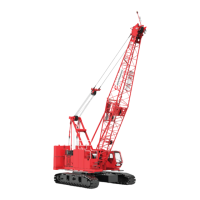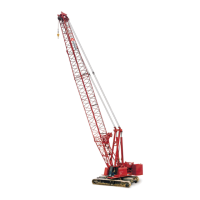Manitowoc Published 08-06-19, Control # 237-09_v2 4-119
MLC165-1 OPERATOR MANUAL SETUP AND INSTALLATION
c. Avoid a reverse bend when winding the wire rope
onto the drum (5): wind from the top of the shipping
reel (1) to the top of drum (4, upper view) or from the
bottom of the shipping reel (4) to the bottom of the
drum (5, lower view).
d. Avoid dragging the wire rope in the dirt or around
objects that can scrape, nick, cut, or crush the wire
rope.
2. Carefully inspect the drums and all rope guides, rollers,
and sheaves for defects that can cause the wire rope to
wear or be cut. If defects cannot be fixed, replace the
faulty parts.
3. Apply tension to the wire rope as it is wound slowly onto
the drum.
a. The first wrap of wire rope must be tight against the
drum flange for the approximately three-fourths of
the drum diameter (Figure 4-93
, View A).
b. Tap adjacent wraps against each other with a soft
metal or wooden mallet as the wire rope is spooled
onto the drum.
c. Use extreme care not to put twists or turns in the
wire rope. Allow the rope to assume its natural lay.
Breaking in Wire Rope
After installing a new wire rope, break it in by operating it
several times under a light load at reduced speed. This
practice allows the wire rope to form its natural lay and the
strands to seat properly.
NOTE The wire rope will stretch during the break-in
period, reducing the wire rope’s diameter as the
strands compact around the core.
The dead wraps of wire rope on the drum can become slack
during operation, even if the utmost care is used during
installation of the wire rope. This slackening is caused by the
normal stretch that occurs in a new wire rope under tension
and periodically throughout the wire rope’s life from release
of the load.
When slackness is noted, tightly wind the dead wraps of wire
rope onto the drum. If left uncorrected, a wedging action with
subsequent layers will occur, and the resultant abrasion may
cause broken wires in the dead wraps.
CAUTION
Avoid Wire Rope Damage
Voids or spaced wraps (Figure 4-93, View B) in the first
layer will permit movement and a wedging action with the
subsequent layers. The wedging action will cause
crushing and abrasion of the wire rope.
Never allow the rope to “cross-wind” on the drums.
Wraps of First Layer Tight Against
Drum Flanges and Each Other Wedge
Tight Against Drum Flange
for 3/4 of Diameter
Voids and Loose Wraps in First Layer
Cause Severe Wear of Wire Rope
Figure 4-93
P448
P449
View A
View B
